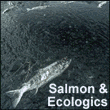forum
library
tutorial
contact

Oregon Now Allowed to
Lethally Remove Sea Lions
by Staff
Newport News Times, March 19, 2008
|
the film forum library tutorial contact |

|
Oregon Now Allowed to
by Staff
|
The National Oceanic and Atmospheric Administration Monday gave Oregon and Washington Departments of Fish and Wildlife and Idaho Fish and Game federal authority to remove - through lethal or non-lethal means - California sea lions preying on salmon and steelhead listed for protection under the Endangered Species Act (ESA).
Fish and wildlife agencies from Oregon, Washington and Idaho jointly requested the authority in 2006 under provisions of the Marine Mammal Protection Act. NOAA-fisheries approved the request on the recommendation of an 18-member federal task force convened last year to review it.
"This federal authorization gives us an additional tool to protect threatened and endangered wild salmon and steelhead runs," said Robin Brown, ODFW program leader for marine mammal research. "However, we will first review the letter of authorization given to the states ... by NOAA Fisheries, and over the next week, we will finalize our plans based on the details of the authorization."
Federal authorization to remove a California sea lion from the waters below Bonneville Dam carries a number of conditions:
So far, several zoological facilities contacted by NOAA Fisheries nationwide have tentatively agreed to accept about a dozen Columbia River sea lions, although arrangements have not been confirmed. NOAA Fisheries must approve such transfers.
For the past three years, hazing crews from ODFW, the Washington Department of Fish and Wildlife, U.S. Army Corps of Engineers, and the Columbia River Inter-Tribal Fish Commission have used flares, rubber bullets and other non-lethal measures in an effort to prevent California sea lions from feeding on ESA-listed fish. Despite those efforts, the corps has documented an increasing rate of predation by sea lions immediately below Bonneville Dam, 145 miles up the Columbia River.
According to a press release from ODFW, for the past four years, up to 100 individual California sea lions have been observed feeding below the dam, most during the peak months of April and May. An adult California sea lion typically eats five to seven salmon a day. Last spring, sea lions consumed nearly 4,000 fish, representing 4.2 percent of the run. In 2002, the corps watched 31 individual sea lions consume 1,010 salmon and steelhead below the dam, accounting for 0.4 percent of the upriver run.
"This is a sensitive situation; we are trying to restore the balance between a protected species and one that is endangered and threatened," said Brown. "However, we have to address this issue, because we have a responsibility to protect threatened salmon and steelhead from increasing predation."
Oregon will not move forward on the federal authorization until the State of Washington completes a State Environmental Policy Act (SEPA) environmental review. The review is required by Washington State law and takes approximately two weeks - including a public comment period.
NOAA Fisheries solicited public comments on the states' request for 30 days as part of an environmental assessment earlier this year.
The Humane Society of the United States announced its strong opposition to the plan that would allow state agents to shoot as many as 85 California sea lions at Bonneville Dam on the Columbia Rivers straddling Oregon and Washington.
According to a press release from the HSUS, the normal average salmon consumption is 0.4 to 4.2 percent of salmon returns this year, even though Oregon and Washington State recently proposed to increase fishing quotas by 33 percent (from 9 to 12 percent of the run) in light of record salmon returns for 2008.
"The claim that sea lions must die to protect salmon is entirely bogus, and more than a little disingenuous," said John Balzar, HSUS senior vice president of communications. "If the government really thought salmon are so critically imperiled that we need to start slaughtering their natural predators, they wouldn't allow fisherman to catch three times more fish than sea lions are eating."
The group counters that other major causes of salmon include: dams, which the National Marine Fisheries Service estimated the Federal Columbia River Power System kills 16.8 percent of adult Snake River Basin Steelhead and 59.9 percent of juveniles; while fishing, incidental takes range between 5.5 and 17 percent of the Upper Columbia spring Chinook and Upper Snake River spring/summer Chinook; birds consumed 18 percent of juvenile salmonids reaching the Columbia River estuary in 1998; and in 2003, NMFS authorized a research permit to take 4.8 percent of listed sockeye.
The release states the plan to shoot sea lions coincides with estimates that this spring's Columbia Rivers salmon run is likely to be the third largest in almost 30 years, and a likely 200 percent increase in total fish over 2007.
Related Pages:
Survival of Snake River Salmon & Steelhead data compiled by bluefish.org, July 2004
learn more on topics covered in the film
see the video
read the script
learn the songs
discussion forum
